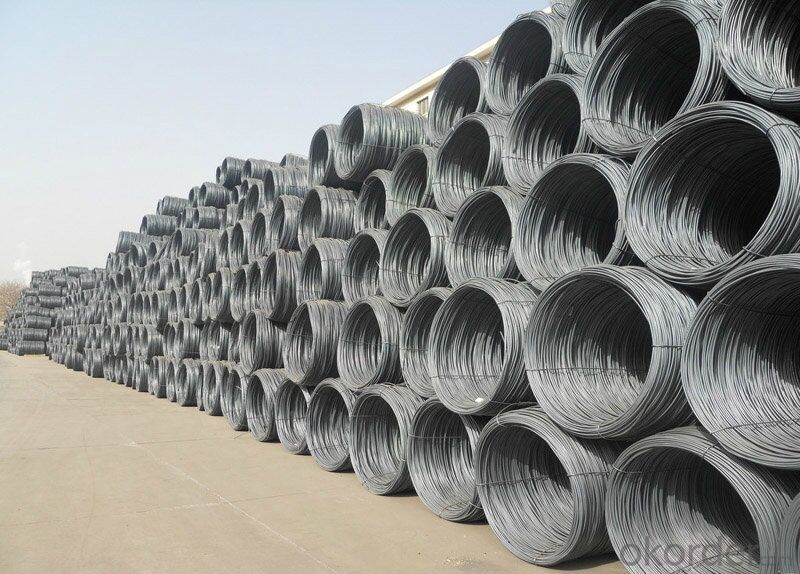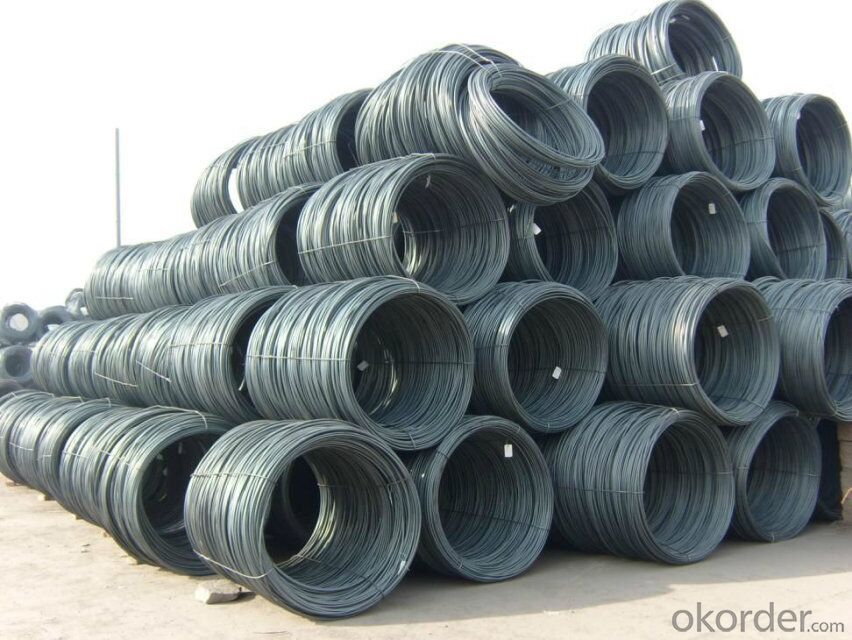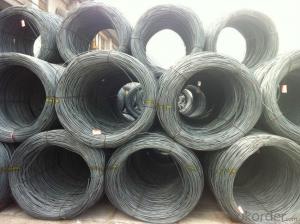wholesale carbon hot rolled steel wire rod in coil with lower price
- Loading Port:
- Tianjin
- Payment Terms:
- TT OR LC
- Min Order Qty:
- 25 m.t.
- Supply Capability:
- 5000 m.t./month
OKorder Service Pledge
OKorder Financial Service
You Might Also Like
Item specifice
Specifications of Steel Wire Rod in Coil:
Steel Grade: Q195/235, SAE1006-1018B Standard: ASTM, GB
Diameter: 5.5mm, 6.5mm, 7mm,8mm,9mm,10mm,12mm,14mm
Type: Drawn Wire Alloy or Not: Alloy Brand Name: HSKY
Technique: Hot Rolled Place of Origin: China Mainland
Chemical Composition:(Please kindly find our chemistry of our material based on SAE1006B and SAE1008B as below for your information)
High carbon/Low carbon/common carbon Steel wire rod | With boron for rebate tax |
Grade | SAE1006B SAE1008B SAE1018B |
Package | In coil ,in bundle, |
Coil weight | about 2000kg-3000kgs |
Size: | 5.5mm 6.5mm 8mm 10mm 12mm 14mm 16mm |
Types | High Carbon ,Low carbon ,Common carbon |
Exported Country | South Korea,Vietnam,Indonesia,Myanmar,Philippines and Afrca,Ect |
Delivery term: | within 30 days after receive the LC |
Payment Term: | LC at sight ,LC 30-120 days after B/L date, TT payment |
The Standard of Physical Properties:
Grade | Chemical Composition(%) | |||||
C | Mn | Si | S | P | Cr | |
SAE1006 | 0.03~O.07 | ≤0.32 | ≤0.30 | ≤0.045 | ≤0.040 | >0.30 |
Mechanical properties | ||||||
Yield strength(N/mm2) | Tensile strength(N/mm2) | Elongation(%) | ||||
250-280 | 350-380 | ≥32 | ||||
Grade | Chemical Composition(%) | |||||
C | Mn | Si | S | P | Cr | |
SAE1008 | 0.10max | 0.3~O.50 | 0.15max | 0.050max | 0.040 max | 0.30 min |
Mechanical properties | ||||||
Yield strength(N/mm2) | Tensile strength(N/mm2) | Elongation(%) | ||||
≥195 | 315-430 | ≥30 | ||||
Usage and Applications of Steel Wire Rod in Coil:
After hot-rolled the products shaped into coil and delivery as finished product, including round, square, rectangular, hexagonal and so on, Since most of the products are round, it is generally called wire rod. Steel wire rod is widely used in construction and manufacturing. Steel wire rod is mainly used for reinforcement of reinforced concrete and welded structure or reprocessed (roberts, nail etc) materials, especially used to produce wire drawing, welding electrode, nails,spring, electronic, precise machinery parts and so on.
Packaging & Delivery of Steel Wire Rod in Coil:
Packaging Detail: products are packed in coil and then shipped by container or bulk vessel
Each coil weight: 2-3MT
Delivery Detail: within 45 days after received deposit or LC.
Label: to be specified by customer, generally, each bundle has 1-2 labels
Trade terms: CFR, CIF


- Q:What are the different surface defects that can impact the corrosion resistance of steel wire rod?
- Some of the different surface defects that can impact the corrosion resistance of steel wire rod include pits, scratches, scales, and coatings. These defects can create areas of weakness on the surface of the wire rod, making it more susceptible to corrosion.
- Q:How is steel wire rod used in the manufacturing of wire harness assemblies?
- Steel wire rod is an essential component in the manufacturing process of wire harness assemblies. Wire harness assemblies are intricate systems of wires, cables, and connectors that are used to transmit electrical signals and power in various industries such as automotive, aerospace, and telecommunications. Steel wire rod is typically used as the raw material for manufacturing the wire harnesses. It is first processed and drawn into thin, flexible wires of different gauges and diameters. These wires are then further insulated or coated with materials such as PVC, nylon, or Teflon to provide electrical insulation and protection against abrasion, heat, and moisture. The steel wire rod used in wire harness assemblies offers several advantages. Firstly, steel is a strong and durable material, providing the necessary strength and structural integrity to the wires. This ensures that the wire harness assembly can withstand the rigors of its intended application and environment. Additionally, steel wire rod has excellent electrical conductivity properties, allowing for efficient transmission of electrical signals and power through the wires. This is crucial in applications where high-quality signal transmission is required, such as in automotive electrical systems or telecommunications infrastructure. Moreover, the flexibility of steel wire rod allows for easy bending and shaping during the manufacturing process. This is important for creating complex wire harness assemblies that can fit into tight spaces or follow specific routes within a device or equipment. Overall, steel wire rod plays a vital role in the manufacturing of wire harness assemblies by providing strength, electrical conductivity, and flexibility. Its use ensures the reliability and performance of wire harnesses in various industries, contributing to the seamless functioning of electrical systems.
- Q:What are the different corrosion testing methods for steel wire rod?
- There are several corrosion testing methods for steel wire rod, including salt spray testing, exposure testing in natural environments, electrochemical testing, and accelerated corrosion testing using corrosive liquids or gases. These methods help assess the corrosion resistance and durability of the steel wire rod in various conditions.
- Q:What are the different types of steel wire rod surface cleaning methods for wire galvanizing flux?
- There are several types of steel wire rod surface cleaning methods used for wire galvanizing flux. These include mechanical cleaning methods such as abrasive blasting or shot blasting, chemical cleaning methods like pickling or acid cleaning, and electrolytic cleaning methods. Each method has its own advantages and suitability depending on the specific requirements and condition of the steel wire rod.
- Q:What are the common defects in steel wire rod?
- There are several common defects that can be found in steel wire rods. These defects can affect the overall quality and performance of the wire rods. Some of the most common defects include: 1. Surface defects: Surface defects such as cracks, scratches, and pits can occur during the manufacturing process or due to improper handling. These defects can weaken the wire rod and reduce its durability. 2. Internal defects: Internal defects like seams, laps, and inclusions can occur during the casting or rolling process. These defects can lead to weak spots in the wire rod, making it more prone to breakage under stress. 3. Size and shape defects: Wire rods should have a uniform size and shape to ensure consistent performance. Defects such as variations in diameter, ovality, or improper coiling can affect the wire rod's ability to be used in certain applications. 4. Non-metallic inclusions: Non-metallic inclusions such as oxides, sulfides, and silicates can be present in steel wire rods. These inclusions can reduce the wire rod's strength and ductility, making it more susceptible to failure. 5. Decarburization: Decarburization occurs when the carbon content at the surface of the wire rod is reduced, leading to a softer and weaker outer layer. This defect can affect the wire rod's ability to withstand stress and deformation. It is important to note that the severity and frequency of these defects can vary depending on the manufacturing process and quality control measures implemented by the steel wire rod producer. Regular inspection and testing can help identify and mitigate these defects to ensure the quality and reliability of the wire rods.
- Q:Can steel wire rod be used for welding applications?
- Indeed, welding applications can incorporate steel wire rod. As a filler material, steel wire rods are frequently employed in welding procedures. Generally composed of low carbon steel, they come in diverse sizes and grades to cater to distinct welding necessities. Steel wire rods can be put to use in various welding applications, including arc welding, MIG welding, TIG welding, and spot welding. When utilized correctly, they yield a sturdy and dependable weld. Nonetheless, it is crucial to meticulously choose the suitable wire rod, taking into account the metal type being welded and the specific welding technique employed.
- Q:What are the different packaging materials used for steel wire rod?
- Packaging materials for steel wire rods vary based on factors such as length, weight, protection needed during transportation, and ease of handling. Commonly used materials include steel coils, wooden reels, pallets, cardboard boxes, and plastic wraps. Steel coils are a popular option, as they provide compact and secure packaging that is easy to transport and handle. For longer and heavier wire rods, wooden reels offer a larger and more stable packaging solution, commonly used in construction and industrial applications. Pallets are another option, providing a stable base for wire rods and enabling easy handling with forklifts or pallet jacks. Cardboard boxes are suitable for smaller or specific length wire rods, offering protection during transportation and facilitating storage. In some cases, plastic wraps are used for steel wire rods, particularly when smaller quantities need protection from moisture or dust during transportation. It should be noted that the choice of packaging material depends on the specific requirements of the manufacturer and end user, as well as factors like cost, transportation method, and storage conditions.
- Q:What are the transportation options for steel wire rod?
- The transportation options for steel wire rod typically include trucking, rail transport, and sometimes even shipping by sea or air for long-distance or international deliveries.
- Q:How is the machinability of steel wire rod determined?
- The machinability of steel wire rod is determined by various factors such as its chemical composition, microstructure, hardness, and surface finish. These characteristics affect the ease with which the wire rod can be cut, drilled, or machined. Additionally, factors like the cutting tool material and geometry, cutting speed, and feed rate also play a role in determining the machinability of steel wire rod. By considering these factors, manufacturers can evaluate and optimize the machinability of steel wire rod for specific applications.
- Q:What are the common production processes for lead-coated steel wire rod?
- The common production processes for lead-coated steel wire rod typically involve steps such as wire rod cleaning, lead coating application, drying, and coiling. The wire rod is first cleaned to remove any impurities or contaminants. Then, a lead coating is applied to the wire rod using methods like hot-dipping or electroplating. After the coating is applied, the wire rod is dried to ensure it is fully cured and ready for use. Finally, the coated wire rod is coiled for storage or further processing.
1. Manufacturer Overview |
|
|---|---|
| Location | |
| Year Established | |
| Annual Output Value | |
| Main Markets | |
| Company Certifications | |
2. Manufacturer Certificates |
|
|---|---|
| a) Certification Name | |
| Range | |
| Reference | |
| Validity Period | |
3. Manufacturer Capability |
|
|---|---|
| a)Trade Capacity | |
| Nearest Port | |
| Export Percentage | |
| No.of Employees in Trade Department | |
| Language Spoken: | |
| b)Factory Information | |
| Factory Size: | |
| No. of Production Lines | |
| Contract Manufacturing | |
| Product Price Range | |
Send your message to us
wholesale carbon hot rolled steel wire rod in coil with lower price
- Loading Port:
- Tianjin
- Payment Terms:
- TT OR LC
- Min Order Qty:
- 25 m.t.
- Supply Capability:
- 5000 m.t./month
OKorder Service Pledge
OKorder Financial Service
Similar products
New products
Hot products
Hot Searches
Related keywords




























